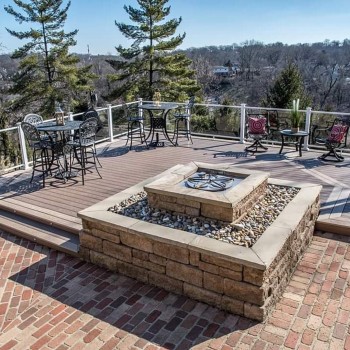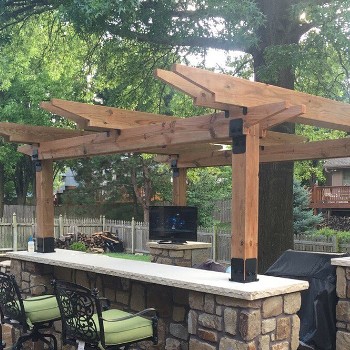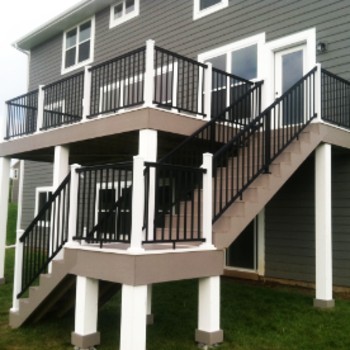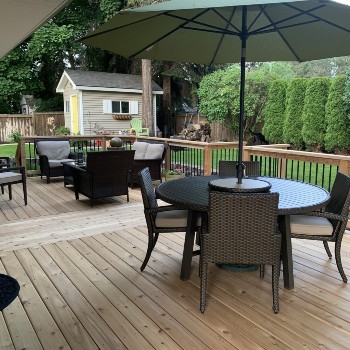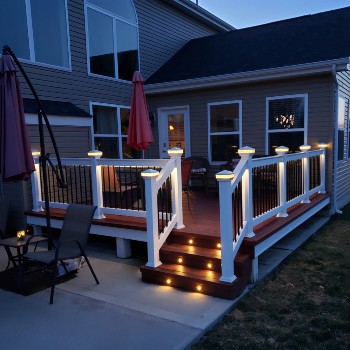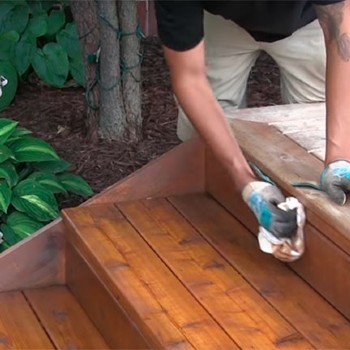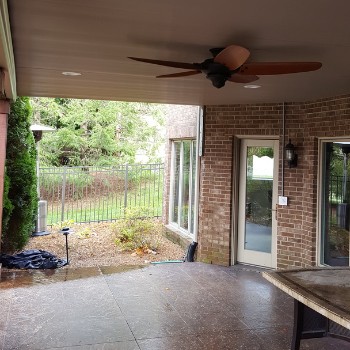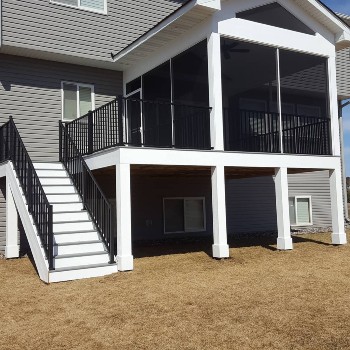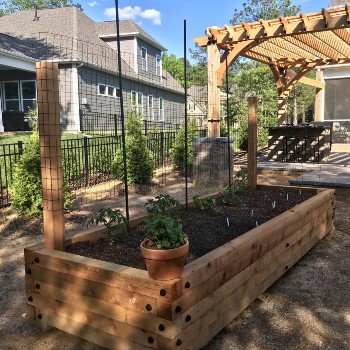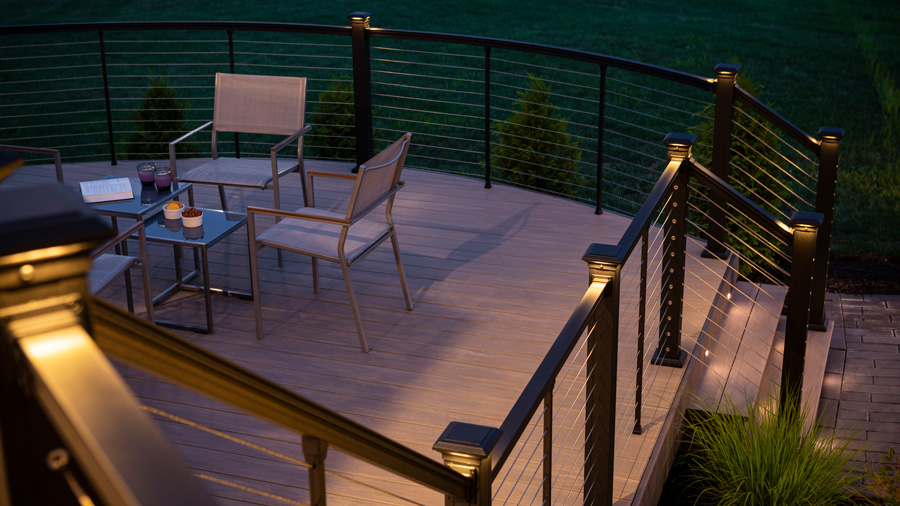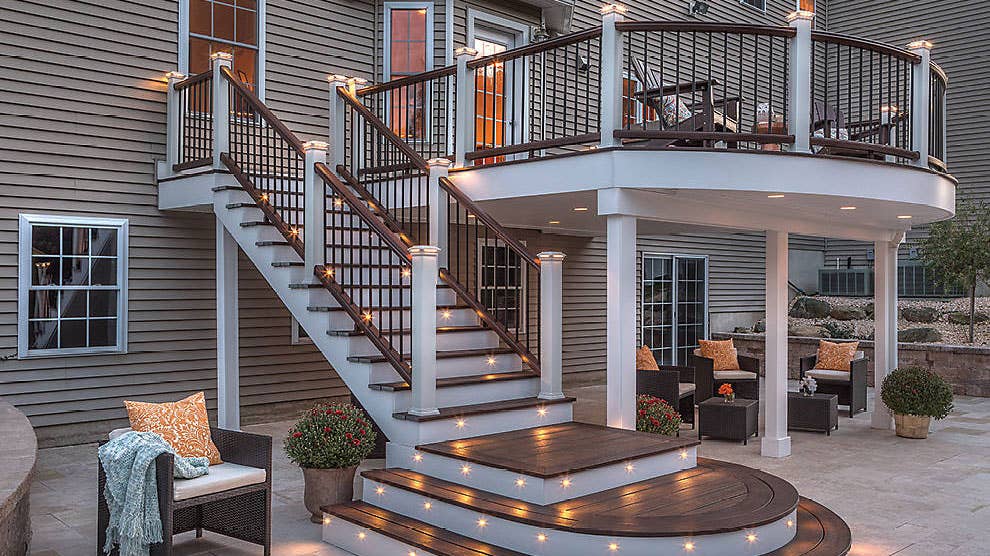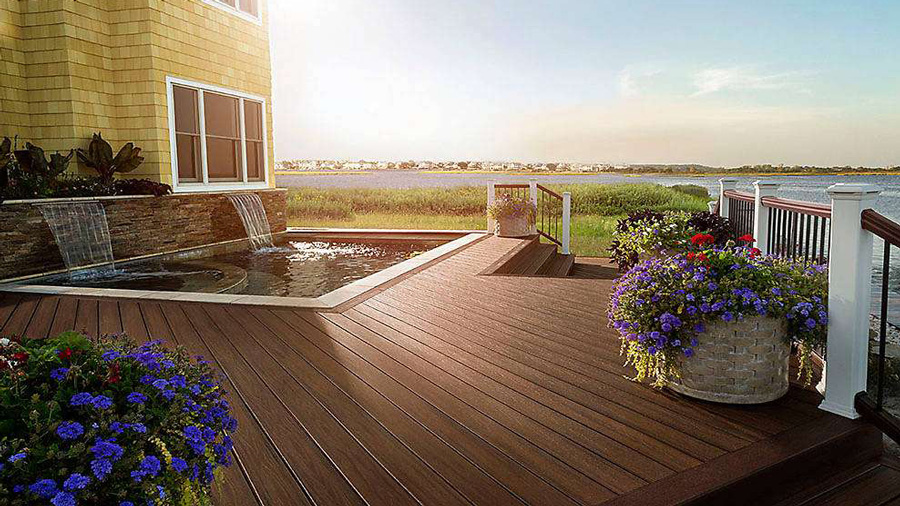The Best Tips and Tricks About Deck Structure Design
Designing, planning, and building your family's dream deck is a beautiful opportunity to create the ideal outdoor space for your home. For some of us, it's also a once-in-a-lifetime chance to build something truly great that will remain for decades to come!
Decks are more than just some boards nailed together, they're an entire living room for your family and guests outside. This is the space where friends will gather, children will grow, and good times will be had by all! Learn more about the notes, styles, and architectural tips to keep in mind as you discover how to design a deck.
And once you've got a strong idea on the look, shape, and atmosphere you want for your outdoor living area, reach out to us here at DecksDirect! Whether you're looking at a brand new start or a fresh end-of-season deck renovation, give our expert deck designers a call at 1-888-824-5316 or send us an email at hello@decksdirect.com. Our deck experts will help you get the information, products, and tools you need for a gorgeous deck that you created and designed!
10 Deck Design Tips
1. Find Inspiration in Online Deck Image Galleries:
If you want to learn how to design a deck, browse through online deck galleries and find details that you love and apply them to your own deck design! Check out the DecksDirect Deck Image Gallery full of beautiful deck builds by professional contractors, DIY builders, all in one place! Check out looks and styles available in composite decking, deck railing systems, LED deck lighting, and more to find what you want for your deck space.
Browse Deck Image Galleries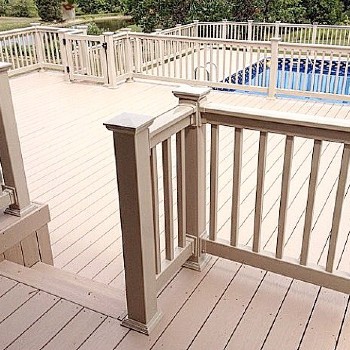
2. Build a Deck That Fits Your Space:
Some builders and architects state that a deck should be no larger than 20 percent of the house’s square footage, so as not to overpower the home visually.
However, if you and your family absolutely love to spend your time outdoors and you plan to split the deck space into several different areas, then design your deck as large as you like! You can design certain areas of your deck to fulfill different roles and it will allow your growing family to spread out while still being together. The best deck structure design is the one that is safe and meets your family's needs.
3. Design for Your Lifestyle:
Are you a family full of party animals? Do you love to cook for big groups of friends and entertain the day away? Or would you prefer a quiet space to enjoy your book and a glass of wine at the end of the day? Thoughts such as these will help you build the deck that fits your lifestyle and achieves exactly what you need. Extroverts can plan a huge outdoor barbeque and entertainment area to watch all of the sports easily, while those who prefer some privacy might install some decorative Privacy Panels to make their space their own. Designing decks is all about your lifestyle.
4. Plan for Foot Traffic:
When planning the layout of your deck, be sure to keep in mind how your guests will be entering, leaving, and moving around your outdoor space. Knowing the path of traffic throughout and across your deck will ensure that there aren't trips over the grill or traffic jams near the entryways. This can also help you decide if you need more than one staircase for your space. Understanding how to design a deck requires careful consideration of your traffic flow.
Also, think about installing secondary handrails along your deck's stairways for increased safety for both children and older guests.
Shop Secondary Handrails5. Add guest seating with deck furniture:
When browsing through the deck images, pick out what types of deck furniture you'd like to add on your deck and patio area and then plan around it! Having an idea of the space you want to present will help with every step of the process.
Would you love an outdoor dining table? Plan for one! Feel like your space is missing something? Maybe a water fountain or fire pit can help liven up an area! The sky's the limit when deciding how to design a deck.
6. Add LED Deck Lighting:
Deck lighting is a fantastic way to accent your backyards features while providing safety for your friends and family. Help your deck be the best spot in the house, day and night, by using deck and landscape lighting to create a unique outdoor space. Choose from stair lighting, recessed lighting, post cap lights, deck rail lights, and more.
Shop LED Deck Lighting7. Plan Ahead to Keep Deck Maintenance Low:
While working on the overall layout and atmosphere you want for your family's outdoor space, start thinking about how much work you'll want to put in maintaining your deck year to year. Most homeowners are moving towards installing premium composite railing or metal deck railing systems to avoid the annual pain of staining.
To help your decking surface remain fade-free and totally resistant to water damage and rot, it's recommended to install composite deck boards in place of the standard pressure-treated or cedar decking. Offering gorgeous, realistic coloring and increased resistance to water, insects, and fade, composite or PVC deck boards from brands like Trex and TimberTech will help you enjoy your deck more and work less.
Browse Composite Decking Brands8. Look forward to a brand new room below deck with Under Deck Drainage:
Adding an under deck drainage system such as ZipUP, UpSide Deck Ceiling, or Trex RainEscape can increase your home's outdoor space even more easily! Gain a completely new room or storage space underneath your upper level deck when you install these water-diverting systems. Whether storing seasonal decorations or toys, or creating a warm, dry spot to lounge during a summer rain; plan on under decking. Deciding how to design a deck includes consideration of every space.
Shop Under Deck Drainage9. Dream up a three-season porch:
Do you and your loved ones love to stay up late on summer nights? Who doesn't! Plan to include a lovely screened-in porch area on your family's deck to keep the good times rolling while preventing mosquitoes, insects and pests from joining the party. Even if you're not ready to install deck screen straight away, at least you'll have a plan in place for a year down the road.
Check out Deck Screen Options10. Look Forward to Expanding Into The Yard:
With your deck design plans starting to form, it's also a great time to think about how you want your deck and backyard space to interact with each other.
This will help you create a cohesive look for your entire outdoor area and will also help ensure that you have space to add a pergola, pavilion, or shade structure you've always wanted. Whether you want to add a relaxing pergola to lounge in your hammock, or need a space to showcase your garden and prize-winning blooms; planning ahead can help you out.
Check out LINX Pergola KitsDon't Skip the Final Step: Post-Construction Inspections
We've gone over the top tips on how to design a deck, but there's still much more to discuss. While the final screw might be in place, your work isn't officially done until the deck passes inspection. Post-construction inspections are your assurance that the structure is:
- Safe
- Up to code
- Built exactly as planned
Skipping this step could lead to fines, forced modifications, or, worse, an unsafe deck that puts users at risk.
Most local building departments require a final inspection to verify that the footings, framing, railing, and overall construction meet code requirements. This is especially crucial if your deck is elevated, supports heavy loads, or connects to your home. Inspectors will check everything from ledger board attachment to proper hardware use, ensuring that your deck is structurally sound and built to last.
Even if you're in an area where inspections aren't mandatory, having a professional give your deck a once-over can help catch small issues before they turn into expensive problems. After all, a well-designed deck should be a source of enjoyment, not stress. Taking the time for a final inspection is the best way to ensure peace of mind—so you can kick back, fire up the grill, and enjoy your new outdoor space without worry.
How Design Complexity Impacts Your Budget
A deck is more than a platform with railings—it's a carefully planned structure where design choices directly impact the bottom line. The more intricate the design, the more materials, labor, and time it requires, which means a higher overall cost. Deciding how to design a deck requires consideration of each factor.
Size and Shape Matter
A simple rectangular deck is the most cost-effective option because it minimizes material waste and speeds up construction. But if you envision multiple levels, curved edges, built-in seating, or custom staircases, expect the price tag to rise. These features require extra framing, specialized cuts, and additional structural support, all of which add to labor and material expenses.
Labor Costs Increase with Complexity
A straightforward deck is relatively quick to build, but a design featuring diagonal deck boards, inlays, or multi-tiered platforms takes significantly more time and expertise. If you want to hire a contractor, skilled labor isn't cheap, and the more intricate the build, the more hours (and dollars) it will require.
Permitting and Inspection Considerations
More elaborate designs may also mean additional permits or stricter code requirements, which could lead to extra costs. For example, a raised deck with an attached pergola may require deeper footings or reinforced framing to meet local building codes.
Balancing Design and Budget
While a complex deck design can create a stunning outdoor space, it's essential to weigh the added costs against your priorities. If budget is a concern, strategic compromises—like simplifying the shape—can help keep costs in check while still delivering a stylish and functional deck.
By understanding how design complexity affects expenses, you can plan a deck that meets your aesthetic goals and your budget without unexpected surprises.
DIY or Hire a Pro? Understanding Time Commitment & Project Scope
Learning how to design and build a deck is an exciting prospect. But before picking up a saw, it’s important to assess the scope of work and the time commitment involved. Whether you go the DIY route or hire a contractor depends on your skill level, available time, and the complexity of your design.
The DIY Approach: What to Expect
If you’re handy with tools and tackling a basic rectangular deck, DIY could be a rewarding (and cost-saving) experience. However, even a straightforward build requires proper planning, permitting, material sourcing, and multiple weekends of labor. More complex designs - multi-level decks, curved edges, or built-in features - demand advanced skills and significantly more time. Expect to spend:
- Nearly two weeks for a simple deck, depending on weather, experience, and available time.
- Longer for intricate designs, especially if additional framing, staircases, or railings are involved.
Hiring a Contractor: Efficiency and Expertise
If time is a concern or the design is beyond your skill level, a professional contractor can streamline the process. While this comes with a higher upfront cost, the tradeoff is faster completion, code compliance, and expert craftsmanship. Professionals can typically complete even complex projects in a week or two, ensuring the deck is safe, level, and built to last.
Making the Right Choice
DIY is ideal for smaller, simpler decks if you have construction experience and time to spare. But hiring a contractor may be best for large or complex designs, ensuring structural integrity and long-term durability.
Weigh your skills, schedule, and project complexity before committing—because the last thing you want is a half-finished deck sitting in your backyard for months.
Frequently Asked Questions About the Best Deck Materials
The $4.1 billion North American deck market can be confusing, but DecksDirect can guide you through every step of the process. Here are some common questions we receive.
What permits do I need to build a deck?
Permit requirements vary by location, but most areas require a building permit for any deck attached to a home or exceeding a certain height. Local codes may also dictate railing height, footing depth, and load capacity. Always check with your local building department before starting construction to avoid fines or project delays.
How do I determine the best size for my deck?
Your deck size should balance available space, intended use, and budget. A good rule of thumb is to ensure there's enough room for outdoor furniture, walkways, and gathering areas without overwhelming your yard. If you plan to host large gatherings, consider at least 300–400 square feet. For smaller seating areas, 150–200 square feet may suffice.
How can I make my deck safer for children and pets?
To child- and pet-proof your deck, install secure railings with vertical balusters spaced no more than four inches apart. Consider adding self-closing gates at staircases and using non-slip decking materials to prevent falls. Read our 11 Tips for a Pet-Friendly Deck for more ideas.
Related Articles
Useful tips and information from the DecksDirect experts to help you design and build the deck of your dreams.


